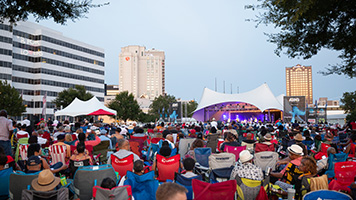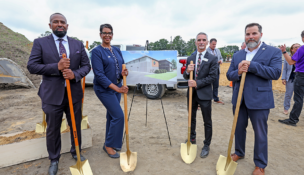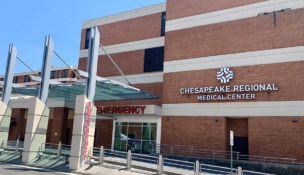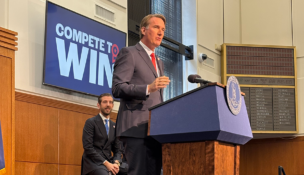A watershed moment
Coronavirus prompts rethinking, but Norfolk hopes for renewed growth
A watershed moment
Coronavirus prompts rethinking, but Norfolk hopes for renewed growth
Only a few months ago, the economies of the historic port city of Norfolk and the greater Hampton Roads region, with which it is inextricably intertwined, were continuing to rebound after emerging from what Old Dominion University’s 2019 State of the Region report has called “the lost decade.”
During the period from 2007 to 2016, Hampton Roads added only one job for every three added in Virginia and every four in the United States.
The region’s economy was constrained by the twin blows of the Great Recession and a severe cutback in defense spending beginning in 2011, commonly known as sequestration.
Then things began turning around.
Economic activity in Hampton Roads grew 2% from 2017 to 2018, more than doubling the previous year’s growth, and growth was expected to jump to 2.4% in 2019, the ODU report says.
More good news came in February when Standard & Poor’s Global Ratings raised Norfolk’s credit rating to AAA on its general obligation bonds, the first time in history that the city — the second-most populous in the state, with approximately 244,000 residents — had earned the highest possible credit rating.
But just when the days ahead seemed brighter, the coronavirus struck, once again threatening Norfolk and the region’s economic growth.
It has caused those in charge of economic development in Norfolk to rethink their mission, at least for the time being, with a hope that the city’s fortunes will quickly resume their upward climb.
Jared Chalk, Norfolk’s director of economic development, was blunt in describing what lies ahead, as long as the effects of the coronavirus linger.
“I’ve told my staff that we’re going to be moving over probably the next several weeks to months into business retention mode and business survival mode,” he says.
“We’re really kind of retooling everything that we’ve done, so that small businesses, restaurants, retail, companies that import [and/or] export goods that have had supply chain issues, all of those things I think will now really be at the forefront of what we’re doing.”
Previously, Chalk says, the city was in a war for talent, a war that he expects will resume once the pandemic runs its course.
New approaches
To better compete regionally and nationally, Chalk says that prior to the COVID-19 upheaval, he took a different approach in Norfolk’s economic development department.
“I’ve really made a shift in the office to focus on companies that export goods and services and bring back money to the region, leveraging the port, leveraging offshore wind,” Chalk says. “The offshore wind industry is new to the state, so we’re all taking a look to see how we can participate.”
Last September, Richmond-based Dominion Energy Inc. revealed its plans for the largest offshore wind development in the country, 27 miles off the coast of nearby Virginia Beach. If approved, 220 wind turbines would provide power for 650,000 homes by generating 2,650 megawatts of zero-carbon electricity.
Chalk also is hoping that Norfolk will benefit from the Navy’s $21 billion effort to upgrade its three public shipyards. A $200 million renovation currently underway at Dry Dock 4 at the Norfolk Navy Naval Shipyard, located in nearby Portsmouth, is part of that upgrade.
When defense spending is strong, Norfolk thrives and is a job creator for the region.
It hosts the world’s largest naval base, Naval Station Norfolk, headquarters of the Navy’s Atlantic Fleet, along with one of NATO’s two Strategic Command headquarters.
Defense spending also drives shipbuilding, and Huntington Ingalls Industries, headquartered in nearby Newport News, is the world’s largest military shipbuilding company, drawing workers from Norfolk and other parts of Hampton Roads and the state.
The Port of Virginia, an economic engine for the region and state, has enjoyed a renaissance over the past several years and Norfolk International Terminals is the port’s largest terminal, lying on 567 acres along the Elizabeth and Lafayette rivers. It has become a magnet for international commerce.

Perhaps the biggest attention-grabber in Norfolk in recent years has been the $700 million resort-style casino being planned by the Pamunkey Indian Tribe.
The General Assembly recently passed legislation allowing commercial casino gambling in Virginia. Aside from Norfolk, the legislation would permit casinos in four other cities: Portsmouth, Richmond, Danville and Bristol.
Before it can proceed, the Pamunkey casino also would require public approval through a local referendum planned for the November ballot.
As initially outlined by the tribe, which is partnering with Tennessee investor Jon Yarbrough, the casino complex would be built on 13 acres east of the Norfolk Tides Harbor Park Stadium and would include a 500-room hotel and five to seven onsite restaurants.
The annual direct economic impact for Norfolk was projected to be $787 million, with about 6.7 million visitors annually.
But Jay Smith, a spokesman for the Pamunkey Tribe, says those projections and the scale of the project might be affected if a proposed casino is built in neighboring Portsmouth.
In any event, Smith says the Pamunkey casino-resort would be a “high-end destination facility” like similar operations in Las Vegas and would be an important piece of Norfolk’s efforts to boost tourism.
Chalk says that although a casino would not be “a silver bullet” for any economic development strategy, it fits in with Norfolk’s efforts to push for an economy that imports dollars.
“So, how do we bring more people to Norfolk?” Chalk asks rhetorically. “Carnival Cruise Line just did a five-year commitment to Norfolk, to do cruises out of Norfolk. We’ve been doing airlines upgrades. We want to change Norfolk into a place people really want to come spend a few days, and I think the casino really complements that.” (Carnival canceled sailings through June 26, cutting nine Norfolk embarkations.)
Another economic initiative Norfolk is undertaking focuses on an effort to become a laboratory for dealing with sea-level rise, Chalk says. According to the National Oceanic and Atmospheric Administration, Hampton Roads is second only to New Orleans in terms of the largest U.S. population centers at risk of flooding from climate change.
“Look at what the Dutch have done,” Chalk says. “They have created an industry around how to live with water, how to live with seawater rise. That’s what we’re looking to do here. What technologies can help? What kinds of tools are out there for not only seawater rise, but large downfalls of rain?”
He says Norfolk is inviting companies to test new technologies in the city, which also has created an Office of Resiliency and was one of the first cities in the country to name a chief resiliency officer.
Kurt Krause, president and CEO of VisitNorfolk, a nonprofit booster organization, is bullish on Norfolk’s future, especially its ability to attract young people to the city and build a talent pool.

“We’ve been recognized as one of the top five cities for millennials to move to, we’re not expensive, the weather is typically pretty good and there’s a lot of water,” Krause says.
VisitNorfolk and the five higher-ed institutions in the city — Old Dominion, Norfolk State, Hampton and Virginia Wesleyan universities and Tidewater Community College — also are bonding in an effort called Campus 757 to brand Norfolk as a college town.
“So, it’s the intent of collaborating with the five education institutions within Norfolk to attract high school students to come to our universities, get jobs, get internships, become engaged in the community and get a job,” Krause says.
He adds that Norfolk has a lot to offer young people and those young of heart with an abundance of festivals: two wine festivals, Harborfest and the Norfolk Waterfront Jazz Festival, to name a few.
“Arguably, we’re also the capital of the arts,” Krause adds. “The Virginia Symphony is here, Ballet Virginia is headquartered here, the Virginia Opera is here, the Virginia Arts Festival is here.”

Norfolk is the only city in Virginia with a Triple-A baseball team, the Norfolk Tides, and it also has a professional hockey team, the Norfolk Admirals.
Changing course
Today, Norfolk’s poverty rate is 22% for individuals and 16% for families. Virginia’s overall poverty rate was 10.7% for 2018, the latest year for which figures have been released.
In an ambitious effort to break the pattern of intergenerational poverty in public housing, Norfolk is working to redevelop the St. Paul’s neighborhood, a 200-acre swath with 1,700 units in three public housing communities, representing the highest concentration of public housing in the region. The goal is to transform the area from low-income housing to mixed-income housing.
Ronald Jackson, recently named executive director of the Norfolk Redevelopment and Housing Authority, says the transformation also involves helping residents to become more self-sufficient through training and education and helping them make the best housing decision for their families.
Norfolk’s efforts in the St. Paul’s neighborhood are supported by a $30 million grant from the U.S. Department of Housing and Urban Development (HUD), along with investments and pledges from the city and its partners for $158 million.
While cautioning that COVID-19 makes any forecast uncertain, ODU economist Robert M. McNab, director of the Dragas Center for Economic Analysis and Policy, says Norfolk’s prospects for the future “are better than they have been in a decade.”
i
















